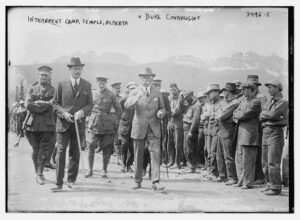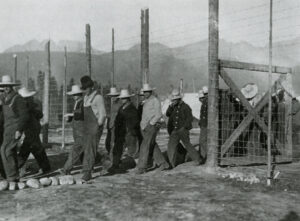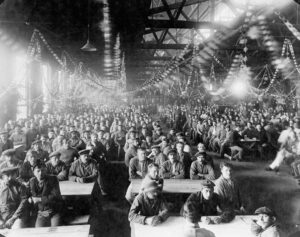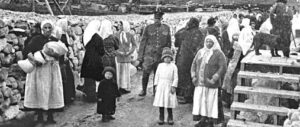Internment 100
Marking the 100th Anniversary of the official end of Canada’s First National Internment Operations 1914–1920
Day 2, “The 24 Internment Camps: Locations Across Canada”
English
During Canada’s first national internment operations (1914–20) at the time of the First World War, thousands of men, women, and children who had emigrated from territories controlled by the Austro-Hungarian Empire, Germany, and the Ottoman Empire were designated “enemy aliens.” This term referred to the citizens of states then legally at war with Canada who were residing in Canada.
Approximately 80,000 individuals were required to report to local Canadian authorities on a regular basis. The majority of them were Ukrainians, and other communities affected included Germans, Poles, Italians, Bulgarians, Croatians, Serbians, Hungarians, Jews, Russians, Slovaks, Slovenes, Czechs, Armenians, Alevi Kurds, Turks, and Romanians. From among these groups 8,579 individuals, including as many as 5,000 Ukrainians, were interned in 24 labour camps across Canada. Almost all of them were civilians. In most cases, the internees were forced to do heavy labour. Today’s main feature video contains images and locations of each of the 24 camps across Canada.
This brochure describes basic facts about Canada’s First National Internment Operations,1914–1920:
https://www.internmentcanada.ca/PDF/172685%20CFWWIRF%20eng%20PROOF.pdf The same informational brochure in French, Ukrainian, Armenian, Bulgarian, Croatian, German, Hungarian, Polish, Romanian and Serbian can be found at https://www.internmentcanada.ca/resources-documents.cfm
Today’s Feature:
Additional Information:
- Перший Гулаг для українців у Канаді (in Ukrainian): https://www.youtube.com/watch?v=qlO6Vo9k7mw
- This digital interactive map links to a series of 26 short documentaries called “The Camps.” Each of these films tells its own unique story. Click on an internment camp community to view a video or read a newspaper article dating from 1914 to 1920: https://www.internmentcanada.ca/map.cfm
- Map of the internment camps: https://www.internmentcanada.ca/resources-map.cfm and list of the internment camps: https://www.internmentcanada.ca/resources-camp-list.cfm (English and French)
Join us tomorrow, June 3, for the next installment of Internment 100 “The Recovery of Memory”
French
Les camps d’internement, 1914 à 1920
Lors de la première opération d’internement national du Canada (1914-20) au moment de la Première Guerre mondiale, des milliers d’hommes, de femmes et d’enfants qui avaient émigré des territoires contrôlés par l’Empire austro-hongrois, l’Allemagne et l’Empire ottoman ont été désignés “étrangers ennemis”. Ce terme désignait les citoyens des États alors légalement en guerre avec le Canada et qui résidaient au Canada.
Environ 80 000 personnes étaient tenues de se présenter régulièrement aux autorités locales canadiennes. La majorité d’entre eux étaient des Ukrainiens, et les autres communautés concernées comprenaient des Allemands, des Polonais, des Italiens, des Bulgares, des Croates, des Serbes, des Hongrois, des Juifs, des Russes, des Slovaques, des Slovènes, des Tchèques, des Arméniens, des Kurdes Alévis, des Turcs et des Roumains. Parmi ces groupes, 8 579 personnes, dont pas moins de 5 000 Ukrainiens, ont été internées dans des camps de détention et de travail à travers le Canada. La quasi-totalité d’entre eux étaient des civils. Dans la plupart des cas, les internés étaient contraints d’effectuer des travaux pénibles. La vidéo principale d’aujourd’hui contient des images et des emplacements de chacun des 24 camps au Canada.
Cette brochure décrit les faits essentiels des premières opérations nationales d’internement au Canada, de 1914 à 1920 :
https://www.internmentcanada.ca/PDF/172685%20CFWWIRF%20eng%20PROOF.pdf
Cette même brochure d’information dans ces langues – français, ukrainien, arménien, bulgare, croate, allemand, hongrois, polonais, roumain et serbe – peut être consultée à l’adresse:
https://www.internmentcanada.ca/resources-documents.cfm
Rejoignez-nous demain : 3 juin “La récupération de la mémoire”
Ukrainian
Інтернування 100, день 2. Табори інтернування 1914 – 1920 років
Під час канадських перших національних операцій інтернування (1914 – 1920 рр.) у період Першої світової війни, тисячі чоловіків, жінок і дітей, які іммігрували з територій, що були під контролем Австро-Угорської імперії, Німеччини та Османської імперії, були клеймовані як «ворожі іноземці». Цей термін застосовувся до громадян, які іммігрували в Канаду з тих держав, які на той час перебували у стані війни з Канадою.
Близько 80 000 людей були змушені щоденно реєструватися у канадських місцевих органах влади. Більшість із них були українці, проте постраждали також німці, поляки, італійці, болгари, хорвати, серби, угорці, євреї, росіяни, словаки, словенці, чехи, вірмени, курди, турки і румуни. Серед них 8 579 осіб, зокрема, 5 000 українців, були інтерновані у концентраційні та трудові табори, де їх змушували важко працювати. Наше відео сьогодні презентує світлини із усіх 24 таборів Канади.
Цей буклет містить основні факти про канадські перші національні операції інтернування (1914 – 1920 рр.): https://www.internmentcanada.ca/PDF/172685%20CFWWIRF%20eng%20PROOF.pdf
Переклад українською, французькою, вірменською, болгарською, хорватською, німецькою, угорською, польською, румунською і сербською мовами можна знайти тут: https://www.internmentcanada.ca/resources-documents.cfm
Карта таборів інтернування (можна завантажити у форматі PDF англійською та французькою мовами): https://www.internmentcanada.ca/resources-map.cfm
Перелік таборів інтернування (англійською та французькою мовами): https://www.internmentcanada.ca/resources-camp-list.cfm
Долучайтесь до нас завтра. У нашому наступному випуску «Інтернування 100»: 3 червня, «Повернення пам’яті».



